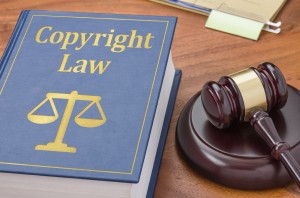 Since the inception of the internet, copyrights have had a somewhat interesting relationship with it (to say the least). From peer-to-peer file-sharing services for digital audio files (think Napster, then later Grokster and Kazaa, to name a few) to the use of photographs on the web, copyrights have not been regularly respected. Copyright protection and enforcement was difficult enough without the internet — the online world has made it that much harder. Let’s be honest — from a copyright holder’s perspective, copyrights have been downright either ignored or under attack by some as “passé,” embodying an outdated concept of ownership at odds with an online world. Consistent with this ignorance of the law, unauthorized (and illegal) file-sharing and use of copyrighted content (especially images) has remained a significant problem. Now, it seems, this problem may have finally found its digital match with the use of blockchain technology.
Since the inception of the internet, copyrights have had a somewhat interesting relationship with it (to say the least). From peer-to-peer file-sharing services for digital audio files (think Napster, then later Grokster and Kazaa, to name a few) to the use of photographs on the web, copyrights have not been regularly respected. Copyright protection and enforcement was difficult enough without the internet — the online world has made it that much harder. Let’s be honest — from a copyright holder’s perspective, copyrights have been downright either ignored or under attack by some as “passé,” embodying an outdated concept of ownership at odds with an online world. Consistent with this ignorance of the law, unauthorized (and illegal) file-sharing and use of copyrighted content (especially images) has remained a significant problem. Now, it seems, this problem may have finally found its digital match with the use of blockchain technology.
By now, you have heard about blockchain technology, or by its more generic name “distributed ledger technology.” In essence, it is a cryptographically secure, digital distributed ledger that can record transactions between parties that is both immutable (permanent) and verifiable. As I have previously written on this topic, the technology uses blocks of data (including data about the transaction itself) and links such data to the previous block in the chain, creating a log of transactions (blocks) linked together (chain) in an encrypted ledger without a centralized administrator. This is replicated and authenticated across a computer network and synchronized so that all the nodes reflect the information as it is updated. This is truly cool technology, but how does this technology apply to copyrighted works? Well, the devil is in the distributed (and encrypted) details.
Let’s use images online as an example — one of the biggest problems for rights holders (i.e., photographers) who place their images online is policing the use of such images. We have all heard stories about companies (and individuals) taking images found online and using them on their websites or in marketing materials without first asking permission from the copyright holder. I am not talking about public domain images here — I am referring to images that were taken by photographers and uploaded onto their websites, or otherwise provided to third-party websites by the copyright holder under license. Under U.S. law, copyright holders enjoy exclusive rights to their original works of authorship that are fixed in a tangible medium of expression. See 17 U.S.C. Section 106. Assuming no valid defenses (such as fair use), commercial use of such copyrighted works without a license usually constitutes copyright infringement. Here is where blockchain just may come to the rescue.
For photographers, platforms are popping up to provide mechanisms whereby their images can be uploaded to a blockchain to provide not only authentication for ownership, but a means to police unauthorized use. For example, Binded touts itself as “the world’s first copyright platform” for blockchain, creating “a unique fingerprint (also known as a cryptographic hash) for each copyright record… [that] contains the image file as well as the copyright owner’s name and email.” By uploading a batch of these to the blockchain daily, Binded is creating a secure chain of immutable records. With a digital fingerprint at its fingertips, copyright owners can then digitally police online sites, including social media platforms like Instagram and Twitter.
COPYTRACK is another exciting blockchain-based copyright enforcement service provider, using its “Global Decentralized Copyright Registry” (funded by an initial coin offering, or ICO) for copyright owners. What sets COPYTRACK apart is that it is not limited to just photographs, but any type of digital content (music files, anybody?). Further, COPYTRACK polices on a commission basis — its platform can be used by photographers to police unauthorized uses of their images and then have COPYTRACK resolve the infringement with the infringing owner by coordinating payment of an owner-preset license fee (COPYTRACK keeping 30% of such fees paid by the infringing users, or 50% where such cases go to court outside of Germany). With an enforcement process in over 140 countries, COPYTRACK is positioning itself to provide a truly global solution using public blockchain as its foundation. In fact, even Kodak is getting into the act with its KodakOne offering (albeit limited to photographic images, using the Ethereum blockchain with its own KodakCoin cryptocurrency for license payments).
Blockchain technology is shaping up to be transformational for copyright holders trying to protect their copyrights online. Without question, it has just begun making its presence known for copyright holders. Whether the enforcement mechanisms outlined for these platforms will actually perform in practice has yet to be seen, but the prospects remain encouraging. This does not mean that all the kinks are worked out — as blockchain records are immutable, questions regarding initial authentication in the uploads need to be answered. Further, whether the compensation model works in situations of protracted enforcement, or with specific cryptocurrencies (or conversions of such cryptocurrencies to traditional currency) given cryptocurrency volatility has yet to be seen. When it comes to online copyright protection and enforcement, however, blockchain technology is shaping up to handle the challenge. In fact, it seems that it is placing its digital fingerprints all over it.

How Legal Intelligence Is Bringing In A New Era Of Litigation For Plaintiff Firms
Darrow is building a new category of legal intelligence — one that helps firms understand complex legal landscapes earlier, more clearly, and with greater confidence.
 Tom Kulik is an Intellectual Property & Information Technology Partner at the Dallas-based law firm of Scheef & Stone, LLP. In private practice for over 20 years, Tom is a sought-after technology lawyer who uses his industry experience as a former computer systems engineer to creatively counsel and help his clients navigate the complexities of law and technology in their business. News outlets reach out to Tom for his insight, and he has been quoted by national media organizations. Get in touch with Tom on Twitter (@LegalIntangibls) or Facebook (www.facebook.com/technologylawyer), or contact him directly at [email protected].
Tom Kulik is an Intellectual Property & Information Technology Partner at the Dallas-based law firm of Scheef & Stone, LLP. In private practice for over 20 years, Tom is a sought-after technology lawyer who uses his industry experience as a former computer systems engineer to creatively counsel and help his clients navigate the complexities of law and technology in their business. News outlets reach out to Tom for his insight, and he has been quoted by national media organizations. Get in touch with Tom on Twitter (@LegalIntangibls) or Facebook (www.facebook.com/technologylawyer), or contact him directly at [email protected].
